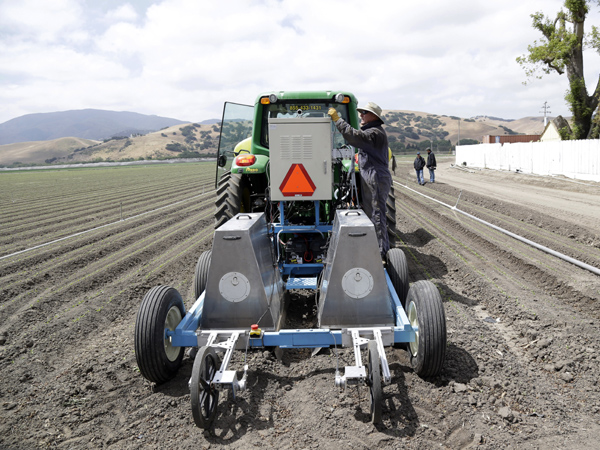Robots to revolutionize farming, ease labor woes... -

On a windy morning in California's Salinas Valley, a tractor pulled a wheeled, metal contraption over rows of budding iceberg lettuce plants. Engineers from Silicon Valley tinkered with the software on a laptop to ensure the machine was eliminating the right leafy buds.
The engineers were testing the Lettuce Bot, a machine that can "thin" a field of lettuce in the time it takes about 20 workers to do the job by hand.
The thinner is part of a new generation of machines that target the last frontier of agricultural mechanization - fruits and vegetables destined for the fresh market, not processing, which have thus far resisted mechanization because they're sensitive to bruising.
Researchers are now designing robots for these most delicate crops by integrating advanced sensors, powerful computing, electronics, computer vision, robotic hardware and algorithms, as well as networking and high precision GPS localization technologies. Most ag robots won't be commercially available for at least a few years.
In this region known as America's Salad Bowl, where for a century fruits and vegetables have been planted, thinned and harvested by an army of migrant workers, the machines could prove revolutionary.
Farmers say farm robots could provide relief from recent labor shortages, lessen the unknowns of immigration reform, even reduce costs, increase quality and yield a more consistent product.
"There aren't enough workers to take the available jobs, so the robots can come and alleviate some of that problem," said Ron Yokota, a farming operations manager at Tanimura & Antle, the Salinas-based fresh produce company that owns the field where the Lettuce Bot was being tested.
Many sectors in U.S. agriculture have relied on machines for decades and even the harvesting of fruits and vegetables meant for processing has slowly been mechanized. But nationwide, the vast majority of fresh-market fruit is still harvested by hand.
Research into fresh produce mechanization was dormant for years because of an over-abundance of workers and pressures from farmworker labor unions.
In recent years, as the labor supply has tightened and competition from abroad has increased, growers have sought out machines to reduce labor costs and supplement the nation's unstable agricultural workforce. The federal government, venture capital companies and commodity boards have stepped up with funding.
Read more -

On a windy morning in California's Salinas Valley, a tractor pulled a wheeled, metal contraption over rows of budding iceberg lettuce plants. Engineers from Silicon Valley tinkered with the software on a laptop to ensure the machine was eliminating the right leafy buds.
The engineers were testing the Lettuce Bot, a machine that can "thin" a field of lettuce in the time it takes about 20 workers to do the job by hand.
The thinner is part of a new generation of machines that target the last frontier of agricultural mechanization - fruits and vegetables destined for the fresh market, not processing, which have thus far resisted mechanization because they're sensitive to bruising.
Researchers are now designing robots for these most delicate crops by integrating advanced sensors, powerful computing, electronics, computer vision, robotic hardware and algorithms, as well as networking and high precision GPS localization technologies. Most ag robots won't be commercially available for at least a few years.
In this region known as America's Salad Bowl, where for a century fruits and vegetables have been planted, thinned and harvested by an army of migrant workers, the machines could prove revolutionary.
Farmers say farm robots could provide relief from recent labor shortages, lessen the unknowns of immigration reform, even reduce costs, increase quality and yield a more consistent product.
"There aren't enough workers to take the available jobs, so the robots can come and alleviate some of that problem," said Ron Yokota, a farming operations manager at Tanimura & Antle, the Salinas-based fresh produce company that owns the field where the Lettuce Bot was being tested.
Many sectors in U.S. agriculture have relied on machines for decades and even the harvesting of fruits and vegetables meant for processing has slowly been mechanized. But nationwide, the vast majority of fresh-market fruit is still harvested by hand.
Research into fresh produce mechanization was dormant for years because of an over-abundance of workers and pressures from farmworker labor unions.
In recent years, as the labor supply has tightened and competition from abroad has increased, growers have sought out machines to reduce labor costs and supplement the nation's unstable agricultural workforce. The federal government, venture capital companies and commodity boards have stepped up with funding.
Read more -

No comments:
Post a Comment